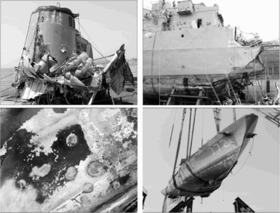
Back غرق الفرقيطة تشونان Arabic Ναυάγιο του Τσεονάν Greek Korvetti Cheonanin uppoaminen Finnish Incident de Baengnyeong French טיבוע הקורבטה צ'אונן HE Affondamento della Cheonan Italian 天安沈没事件 Japanese 천안함 피격 사건 Korean Peristiwa Baengnyeong Malay Incydent koło Wyspy Baengnyeong Polish
| ROKS Cheonan sinking | |||||||
|---|---|---|---|---|---|---|---|
| Part of the Korean conflict | |||||||
 Four photos show damage to ROKS Cheonan — clockwise from upper left: (1) a damaged stack; (2) front portion (port side) showing the break point; (3) a large fragment is lifted from the sea; (4) water pressure marks on the hull bottom. | |||||||
| |||||||
| Belligerents | |||||||
|
| |||||||
| Commanders and leaders | |||||||
|
|
| ||||||
| Strength | |||||||
| 1 Pohang-class corvette | 1 Yono-class submarine | ||||||
| Casualties and losses | |||||||
|
46 killed 58 wounded ROKS Cheonan sunk | None | ||||||
| Date | 26 March 2010 |
|---|---|
| Time | 21:22 Korea Standard Time |
| Participants | |
| Property damage | 1 ROKN corvette sunk, 46 personnel killed, 58 personnel wounded |
| Inquiries | International investigation convened by ROK government, Russian Navy investigation |
| Charges | ROK-convened (JIG) investigation concludes that DPRK sank the corvette using a midget submarine-launched torpedo. Investigation results are disputed. North Korea denies involvement. |
| ROKS Cheonan sinking | |
| Hangul | 천안함 피격 사건 |
|---|---|
| Hanja | 天安艦被擊事件 |
| Revised Romanization | Cheonanham pigyeok sageon |
| McCune–Reischauer | Ch'ŏnanham p'igyŏk sakŏn |
The ROKS Cheonan sinking occurred on 26 March 2010, when Cheonan, a Pohang-class corvette of the Republic of Korea Navy, carrying 104 personnel, sank off the country's west coast near Baengnyeong Island in the Yellow Sea, killing 46 seamen. The cause of the sinking remains in dispute.
A South Korean-led official investigation carried out by a team of international experts from South Korea, the United States, the United Kingdom, Canada, Australia, and Sweden[1][2] presented a summary of its investigation on 20 May 2010, concluding that the warship had been sunk by a North Korean torpedo[3][4] fired by a midget submarine.[5] The conclusions of the report resulted in significant controversy within South Korea. Following the sinking, South Korea imposed sanctions against North Korea, known as the May 24 measures.
North Korea denied that it was responsible for the sinking.[6] North Korea's further offer to aid an open investigation was disregarded.[7] China dismissed the official scenario presented by South Korea and the United States as lacking in credibility.[8] The results of an investigation by the Russian Navy were not made public. The United Nations Security Council made a Presidential Statement condemning the attack but without identifying the attacker.[9]
- ^ Cite error: The named reference
UN-S/2010/281was invoked but never defined (see the help page). - ^ Cite error: The named reference
ROKMOD-report-592was invoked but never defined (see the help page). - ^ "Results Confirm North Korea Sank Cheonan". Daily NK. 20 May 2010. Archived from the original on 22 May 2010. Retrieved 20 May 2010.
- ^ Barrowclough, Anne (20 May 2010). "'All out war' threatened over North Korea attack on warship Cheonan". The Times. London. Archived from the original on 22 May 2010. Retrieved 25 May 2010.
- ^ Cite error: The named reference
yonowas invoked but never defined (see the help page). - ^ "Press Conference on Situation in Korean Peninsula: DPRK Permanent Representative to the United Nations Sin Son Ho". Department of Public Information. United Nations. 15 June 2010. Retrieved 11 July 2010.
- ^ Watson, Paul (19 July 2012). "South Korea good, North Korea bad? Not a very useful outlook". The Guardian. Retrieved 9 November 2023.
- ^ Cite error: The named reference
new american mediawas invoked but never defined (see the help page). - ^ "Presidential Statement: Attack on Republic of Korea Naval Ship 'Cheonan'". United Nations Security Council. United Nations. 9 July 2010. S/PRST/2010/13. Retrieved 11 July 2010.